Dieting, Physical Health, and Food Security
Eva K Lee*
Center for Operations Research in Medicine and Healthcare, Georgia Institute of Technology Atlanta, GA USA
Submission: September 22, 2020; Published: October 01, 2020
*Corresponding author: Eva K Lee, Center for Operations Research in Medicine and Healthcare, Georgia Institute of Technology Atlanta, GA, USA
How to cite this article: Eva K Lee*. Dieting, Physical Health, and Food Security. J Phy Fit Treatment & Sports. 2020; 8(2): 555738. DOI: 10.19080/JPFMTS.2020.08.555738
Keywords: Physical activities; Chronic diseases; Obesity; Diabetes; Cardiovascular diseases; Cancer; Hypertension; Gardening; Daily household chores; Food security; Hunger; Mental and emotional well-being
Opinion
Healthy Diet and Challenges A diet with good nutrition and proper physical activities promotes good health and reduces disease risks. Chronic diseases such as obesity, diabetes, cardiovascular diseases, cancer, and hypertension are among the most common causes of death in the world. They impose enormous social and healthcare burdens. In the United States, chronic diseases account for roughly 70% of the deaths of all Americans and 75% of the annual healthcare expense. Better diets with regular exercise and healthy lifestyles (e.g., stop smoking) possibly could reduce chronic disease by as much as 50%. The internet offers plenty of dieting plans and exercises to promote health. Losing weight very often is less difficult than maintaining the achieved lower weight. Whether or not the weight loss is extreme, a yo-yo effect is common as one goes through a cycle of losing weight and then regaining it. Frequently athletes have a trainer to help them sustain their “ideal” weight for high-level sports performance. Ordinary people who are dieting for weight reduction may have a harder time because it simply is hard to keep up healthy eating.
To reduce the burden of chronic disease, it would be extremely helpful to improve average lifestyle patterns. Modernization seems to discourage our natural physical activities. Yet an increase in walking, biking, walking up the stairs, gardening, raking leaves, playing kites, tidying the house, cooking, doing dishes, and so on would go a long way to enhance our bodies and minds. Scientifically minded nutritionists work diligently to design personalized meals that maintain health and inspire good eating habits. Mathematical models have long been used in dietary planning. Most such models are designed to consider calories and nutritional requirements, expected physical activities, and potential dietary restrictions imposed by personal preferences, existing diseases, or allergies. These models, however, often fail to allow for human behavior and social determinants, factors that often play a major role in affecting people’s eating habits, their access to and ability to afford proper food, and their physical activities. Yet sophisticated models can be developed to incorporate human behavior, limitations on food access, and other external factors. Such improved approaches would ensure the resulting diets are realistic, personalized, and sustainable so as to facilitate good outcomes. But among all these healthy diet challenges lies a particularly grave danger: food insecurity.
How can the poor maintain healthful diets? We can readily add cost and access constraints to these models. But is it realistic to assume the poor can actually maintain good health? What type of food can they in fact afford? What are their real living conditions? In the richest nation on earth, millions of Americans go to bed hungry. In 2019, 12.5% of Americans received food stamps and over 20 million children received free lunches at schools. Is healthcare a right or a privilege? If food is essential to health, is food a right or a privilege?
Covid-19 and A World in Hunger The covid-19 pandemic has exacerbated the severe food insecurity and health disparity situation in the United States. The lockdowns and the layoffs have created epic long lines at food banks. Also, it is harder to access food since many small family-owned grocery stores collapsed (as a result of the lockdowns) within impoverished neighborhoods. Many more families struggle to feed their children. Around the world, covid-19 has set back decades of progress in fighting hunger, poverty, illiteracy, and childhood health protection via vaccination.
Because of coexisting health conditions and poor healthcare access, a disproportionate number of underserved and minority populations have suffered unequally from the covid-19 pandemic. For example, African Americans and Hispanics infected with covid-19 are four-times more likely than average to require hospitalization, and African Americans are twice as likely to die from the disease. And these groups also tend to suffer more complications during treatment.
How can a person maintain physical fitness during the pandemic crisis? While the struggling poor may not have the luxury to think about fitness, even the worried-well who can afford it find their physical health is being challenged as people spend more time in front of their computers and digital devices, toiling away in hours of online meetings and online classes. Some may indulge in video games or online chats. Parents often are overwhelmed with their work combined with school arrangements at home. Homecooking may promote health, but physical activities or exercises have been reduced. Furthermore, the economic calamity, the isolation and loneliness, the stress of multi-tasking and sharing space in close quarters, plus the anxiety, fear, or trauma from the disease, have escalated mental health burdens across the nation.
America is under siege. How can we manage health in times of a pandemic? How may a person maintain physical fitness, when staying healthy indeed is of paramount importance? How might people carry out group sports when social distancing is crucial to mitigate and contain spreading the disease? How about physical fitness, sports and the poor? Fresh produce and nutritional food are often not affordable or accessible to the poor. How can they maintain physical fitness when their regular diets include much processed food and are otherwise unhealthy, and when they are housed in crowded quarters with little access to parks? This is a chronic challenge we are facing as a nation, and it is only amplified by the pandemic. As for the well off, they may become stressed, turn to comfort food, and lack enough physical activities. Indeed, studies and surveys have shown that many Americans, perhaps as many as 70%, have gained weight during the covid-19 crisis.
For those who do exercise, there are questions about whether it is necessary to wear face masks when running or exercising outdoors? How about indoor gyms where close contacts are unavoidable? Is it good for the lungs and the heart to exercise with a face mask on? Many studies to seek answers are currently underway.
Most important, we should understand that exercise is beneficial especially during the covid-19 pandemic. Exercise improves mental and emotional health. The massive virtualization of human interaction, the prolonged social and personal isolation, sustained anxiety over job, food, and economic security, household conflicts, along with the loss of loved ones, plus work and safety stresses experienced by essential workers and care takers — all these have taken tolls on emotional and mental-health stability. Physical activity and regular exercise help to reduce anxiety and depression, strengthen resilience, and enhance emotional and situational outlook. While exercising in one’s backyard or private residence is an option that many of us have taken for granted, those under-served, often living with multi-generational families under the same roof, may find it difficult to find the needed private space. Outdoor exercise and activity remain very critical in maintaining physical and emotional well-being.
This short opinion article briefly highlights the challenges in healthy dieting and pursuing physical fitness, and the struggles of food-and-health insecurity among the poor. It also touches upon the toll on physical health of our nation taken by the covid-19 pandemic.
Eva K Lee is a Professor and Director of the Center for Operations Research in Medicine and HealthCare, a center established through funds from the National Science Foundation and the Whitaker Foundation. The center focuses on biomedicine, public health, and defense, advancing domains from basic science to clinical translational research; intelligent, personalized, quality, and cost-effective healthcare delivery; and medical preparedness and protection of critical infrastructures. She is a Distinguished Scholar in Health Systems, Health System Institute at Georgia Tech and Emory University School of Medicine. She previously served as the Senior Health Systems Engineer and Professor for the U.S. Department of Veterans Affairs. She has also served as Co-Director for ten years for the I/UCRC Center for Health Organization Transformation. Email: evalee-gatech@pm.me






























